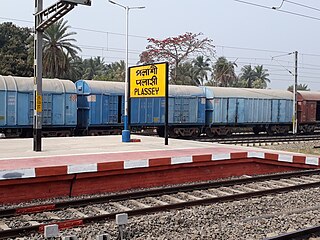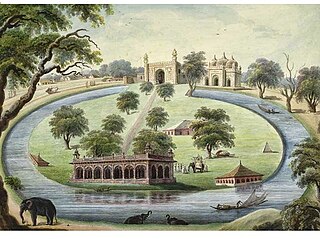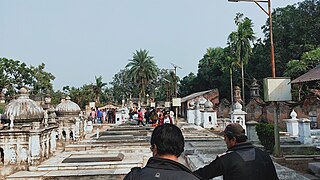
Murshidabad is a historical city in the Indian state of West Bengal. It is located on the eastern bank of the Bhagirathi River, a distributary of the Ganges. It forms part of the Murshidabad district.

Sonargaon is a historic city in central Bangladesh. It corresponds to the Sonargaon Upazila of Narayanganj District in Dhaka Division.

Palashi or Plassey is a village on the east bank of Bhagirathi River, located approximately 50 kilometres north of the city of Krishnanagar in Kaliganj CD Block in the Nadia District of West Bengal, India. The nearest major town is Beldanga. It has its own two local gram panchayat.
Pandua is a census town in the Pandua CD block in the Chinsurah subdivision of the Hooghly district in the Indian state of West Bengal.
Godagari is an Upazila of Rajshahi District in the Division of Rajshahi, Bangladesh. This is the place where Mahananda river fall to Padma or Ganges.

Sarfarāz Khān, born Mīrza Asadullāh, was a Nawab of Bengal. Sarfaraz Khan's maternal grandfather, Nawab Murshid Quli Khan of Bengal nominated him as the direct heir to him as there was no direct heir. After Murshid Quli's death in 1727, Sarfaraz ascended to the Masnad (throne) of the Nawab. Sarfaraz's father, Shuja-ud-Din Muhammad Khan, then the Subahdar of Orissa, getting to know it arrived at Murshidabad, the capital of the Nawabs of Bengal with a huge army. To avoid a conflict in the family the dowager Begum of the Nawab asked Shuja-ud-Din to ascend to the Masnad after Sarfaraz abdicated in favour of his father. However, circumstances led Shuja-ud-Din to nominate Sarfaraz as his heir and after Shuja-us-Din's death in 1739, Sarfaraz Khan again ascended to the Masnad as the Nawab of Bengal.

Sagardighi is a community development block that forms an administrative division in the Jangipur subdivision of Murshidabad district in the Indian state of West Bengal.

Beldanga II is a community development block that forms an administrative division in he Berhampore subdivision of Murshidabad district in the Indian state of West Bengal.

Murshidabad-Jiaganj is a community development block that forms an administrative division in the Lalbag subdivision of Murshidabad district in the Indian state of West Bengal.

The Katra Masjid is a former caravanserai, mosque and the tomb of Nawab Murshid Quli Khan. It was built between 1723 and 1724. It is one of the largest caravanserais in the Indian subcontinent. It was built during the 18th century, when the early modern Bengal Subah was a major hub of trade in Eurasia. The Katra Masjid is located in the north eastern side of the city of Murshidabad, in the Indian state of West Bengal. The most striking feature of the structure are the two large corner towers having loopholes for musketry.

Motijhil, also known as Company's Lake due to its association with the East India Company, is a horse-shoe shaped lake in Murshidabad, West Bengal, India. It was created by Nawazish Muhammad Khan, the son-in-law of Nawab Alivardi Khan. He also constructed a precious palatial palace beside this lake which is called the Sang-i-Dalan which is also known as the Motijhil Palace. It is located at the bend of this lake. It was used as the residence of Nawazish and Ghaseti Begum, Nawazish's beloved wife. It is said that after Nawazish died, Ghaseti Begum lived here until Nawab Siraj ud-Daulah took over the palace and seized the residents' in 1756 AD. With this money he built a similar lake with a beautiful palace, Hirajheel, on the opposite side of the Hooghly River. The palace has a lofty gateway, a mosque known as the "Shahamat Jang" and the Kala Masjid and some other buildings which were all built by Nawazish. This palace was built in 1740. As far as etymology is concerned, the palace has been named so as it was built using black basalt pillars which were brought from the ruins of Gaur. Thus, it was given the name of Sang-i-Dalan or the Stone Palace. This palace was then decorated with different varieties of flower plants and precious marbles.

Fauti Mosque is a mosque at Kumarpur in the Murshidabad-Jiaganj CD block in the Lalbag subdivision of Murshidabad district in West Bengal, India. It was built by Nawab Sarfaraz Khan in 1740 AD. The old Fauti Masjid is one of the largest mosques in the town of Kumarpur and Murshidabad district.

Jafarganj Cemetery is located in Murshidabad, West Bengal, India.
Baranagar is a village in the Murshidabad-Jiaganj CD block in the Lalbag subdivision of Murshidabad district in the state of West Bengal, India.
Tomb of Mir Madan is located at Faridpur, in the Beldanga II CD block in the Berhampore subdivision of Murshidabad district.
Tomb of Azimunissa Begum is located at Azimnagar, in the Murshidabad district.

Yellow Mosque is situated in the Hazarduari Palace complex at Murshidabad, West Bengal, India.
Kherur Mosque is located at Kherur in the Sagardighi CD block in the Jangipur subdivision of Murshidabad district, West Bengal, India.

Dutch Cemetery is a heritage Christian cemetery at Kalikapur in the Berhampore CD block in the Berhampore subdivision of Murshidabad district, West Bengal, India.

Jama Masjid is a congregational mosque located at Motijhil, in the historic city of Murshidabad, West Bengal, India.





















